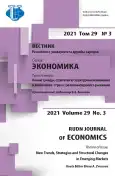Group averaging and the Gini deviation
- Autores: Pavlov O.I.1, Pavlova O.Y.2
-
Afiliações:
- Peoples’ Friendship University of Russia (RUDN University)
- All-Russian Correspondence Multidisciplinary School
- Edição: Volume 29, Nº 3 (2021): New trends, strategies and structural changes in emerging markets
- Páginas: 595-605
- Seção: ECONOMIC AND SOCIAL TRENDS
- URL: https://journal-vniispk.ru/2313-2329/article/view/324215
- DOI: https://doi.org/10.22363/2313-2329-2021-29-3-595-605
- ID: 324215
Citar
Texto integral
Resumo
It is known that partitioning a society into groups with subsequent averaging in each group decreases the Gini coefficient. The resulting Lorenz function is piecewise linear. This study deals with a natural question: by how much the Gini coefficient could decrease when passing to a piecewise linear Lorenz function? Obtained results are quite illustrative (since they are expressed in terms of the geometric parameters of the polygon Lorenz curve, such as the lengths of its segments and the angles between successive segments) upper bound estimates for the maximum possible change in the Gini coefficient with a restriction on the group shares, or on the difference between the averaged values of the attribute for consecutive groups. It is shown that there exist Lorenz curves with the Gini coefficient arbitrarily close to one, and at the same time with the Gini coefficient of the averaged society arbitrarily close to zero.
Palavras-chave
Sobre autores
Oleg Pavlov
Peoples’ Friendship University of Russia (RUDN University)
Autor responsável pela correspondência
Email: pavlov-oi@rudn.ru
PhD, Associate Professor of Economic and Mathematic Modelling Department, Economic Faculty
6 Miklukho-Maklaya St, Moscow, 117198, Russian FederationOlga Pavlova
All-Russian Correspondence Multidisciplinary School
Email: lolgau@yandex.ru
PhD, Associate Professor at the Department of Higher Mathematics
B-234 Vorob'evy Gory, Moscow, 119234, Russian FederationBibliografia
- Arnold, B.C. (2007). The Lorenz curve: Evergreen after 100 years. In S. Betti, A. Lemmi (Eds.), Advances in Income Inequality Concentration Measures (pp. 12-24). New York: Routledge.
- Astashenko, A.N., & Malykhin, V.I. (2012). Income inequality measures. LAP Lambert Academic Publishing.
- Boltyanskij, V.G., Sidorov, Yu.V., & Shabunin, M.I. (1974). Lectures and problems on elementary mathematics. Moscow: Nauka Publ. (In Russ.)
- Ceriani, L., & Verme, P. (2012). The origins of the Gini index: Extracts from Variabilità e Mutabilità (1912) by Corrado Gini. J. Econ. Inequal, 10, 412-443.
- Farris, F.A. (2010). The Gini index and measures of inequality. American Mathematical Monthly, 117(10), 851-864.
- Fellman, J. (2012). Estimation of Gini coefficients using Lorenz curves. Journal of Statistical and Econometric Methods, 1(2), 31-38.
- Gastwirth, J. (1972). The estimation of the Lorenz curve and Gini index. Rev. Econom. Statist, 54, 306-316.
- Gini, C. (1912). Variabilità e mutuabilità: Contributo allo studio delle distribuzioni e delle relazioni statistiche. Bologna: C. Cuppini.
- Golden, J. (2008). A simple geometric approach to approximating the Gini coefficient. The Journal of Economic Education, 39(1), 68-77
- Hoover, E. (1936). The measurement of industrial localization. The Review of Economics and Statistics, 18, 162-171.
- Kakwani, N. (1980). Income inequality and poverty: Methods of estimation and poverty applications. Oxford University Press.
- Kämpke, T., & Radermacher, F.J. (2015). Income modeling and balancing. A rigorous treatment of distribution patterns. Lecture Notes in Economics and Mathematical Systems, 679, 44-53.
- Pavlov, O.I., & Pavlova, O.Yu. (2016). The Lorenz curve and a mathematical definition of the middle class. Management of Economic Systems, (12). Retrieved March 15, 2021, from http://uecs.ru/uecs-94-942016/item/4239-2016-12-24-07-45-16
- Pavlov, O.I., & Pavlova, O.Yu. (2018). Differential deviation and the Gini coefficient. Russian Economics Online-Journal, (4). Retrieved March 15, 2021, from http://www.e-rej.ru/publications/176/%D0%9F/
- Zorich, V.A. (2019). Mathematical analysis (part 1). Moscow: MCCME Publ. (In Russ.)
Arquivos suplementares









